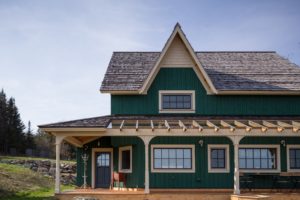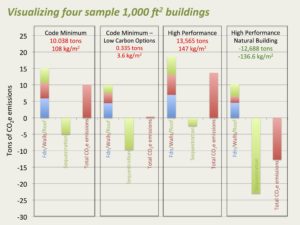
Many locally-sourced wood and other fiber materials were used to build this high-performance home. Builder: New Frameworks. Photo credit: Studio SB Photography, 2016.
By Ace McArleton
“The built environment can switch from being a problem to being a solution.” Bruce King, The New Carbon Architecture (anticipated fall 2017).
Folks, let me introduce you to a new idea: buildings made of sky.
How can we, and indeed why should we, make buildings from sky? While the building industry has taken important strides to reduce our negative impacts, we can and must shift to creating positive impacts by pulling carbon from the atmosphere in the form of plant-based building materials, i.e. “make buildings out of sky.”
We hear a lot about carbon these days and how to minimize its detrimental effects as a greenhouse gas through reducing fossil fuel emissions. Carbon dioxide (CO2) concentration is currently at 400 parts per million (ppm), causing polar ice melt, sea-level rise, and erratic and destructive weather events, all of which have an impact on animal, plant, and human life. The building industry contributes roughly 39%-49% of CO2 emissions globally due to construction and operational use (IPCC 2014, US EPA 2012).
The global carbon impact of building, and hence our responsibility, is massive. We have made great strides in green building in terms of addressing operational energy consumption (the energy that buildings use during their habitation), and we have learned much about how to design and build buildings that consume less energy. Some buildings even produce as much or more energy than they consume through the integration of on-site renewable energy sources; such buildings are called “net zero energy,” and represent a huge step forward for our industry and societies.
However, we must go farther, faster. As Bruce King says in the introduction to his forthcoming book, The New Carbon Architecture: “We are in technological reach, within a generation, of a global construction industry that is not only ‘net zero’…but in its materials pulls more carbon out of the air than it puts up. We can reverse the emissions engine.”
Our current framework for “net zero energy” doesn’t account for the carbon pollution created during the manufacturing and distribution of the materials. The term “embodied carbon” refers to the carbon or carbon-equivalent (the equivalent amount of carbon for other greenhouse gas chemicals) emissions produced as a result of the harvest or extraction, refinement, transport, production/manufacturing, and storage of a material. Many materials used for energy efficient buildings have high embodied carbon loads. It is common to justify these materials’ use, such as foam, based on its “carbon payback time.” Payback is the idea that over the life of the building more carbon will be saved by using the material than is embodied in it. Therefore, the argument goes, over decades of the building’s use the embodied carbon of the material will be “offset” by the amount of operational carbon saved.

“Visualizing Four 1000 ft2 Buildings” slide extracted from “The Carbon Elephant in the Room,” Chris Magwood (Endeavour Center) and Jacob Deva Racusin’s (New Frameworks) research and bar graph comparing carbon emissions and sequestering potentials of various building methods, based on Inventory of Carbon and Energy database (ICE database), 2017.
(Please click on the image to enlarge it.)
We now know several things:
- We don’t have any more time to “offset” anything in this old way of thinking. We have surpassed, and are surpassing, the global atmospheric carbon levels that will maintain any semblance of Earth’s habitable climate as we have known it for the last century. The game has changed, and we must adapt our strategy accordingly and rapidly.
- It is absolutely possible to design, construct, repair, and maintain equally-high performing, energy efficient and durable buildings with not only low- or zero-embodied carbon materials, but with materials, that sequester – or store – carbon, giving that building a net-positive carbon footprint.
- Our buildings then become tools in the project of global drawdown of CO2; they become reservoirs for CO2 and help to reduce and reverse climate change effects.
A gift from aging stars, carbon is the fourth most abundant element in the measurable Universe and the basis of life on Earth. The carbon cycle describes the movement of carbon, in its many forms, between the reservoirs that exist in the atmosphere, oceans, biosphere, and geosphere. Through mining oil and gas reserves, we extract reservoirs of stored carbon and we burn them for fuel. This action impacts the balance of the carbon cycle in a significant way: overloading CO2 in the atmosphere, which warms the planet, and acidifying oceans, which kills ocean life. It is as if carbon sequestration and storage is Earth “inhaling,” while carbon burning, decay, and release is “exhaling”. Our activity has created a huge “exhale” that has gone on and on, overwhelming the cycle’s “inhaling” reservoir capacities, that of the oceans, atmosphere, and biosphere.
Constructing buildings is an opportunity to increase the CO2 sequestering reservoirs and to help bring greater balance to the carbon cycle. When we build with local, plant-based insulations, structural members, and finishes we are engaging in the carbon cycle (intentionally, this time) to reduce carbon in the atmosphere and therefore mitigate, or even reverse, global climate change.
Plants, an important part of the biosphere in the carbon cycle, pull CO2 from the air and convert it into sugar for food. When a tree is harvested for timber, the CO2 that tree absorbed in its lifetime is “fixed” or sequestered into the structure of that timber. As long as it is kept dry and does not rot or burn, that carbon will remain sequestered in that timber and in that building. Plants are the basis of our entire food chain, and they also can form the basis of a sequestration reservoir in our buildings.
There are many excellent examples of carbon-sequestering building materials choices on the market today, for both residential and commercial buildings:
- Straw walls: Insulated prefabricated wall panels or site-built wall structures
- Hempcrete walls: insulation, enclosure in-fill
- Timber and nominal wood framing for structure: CLT (cross-laminated timbers) and big timbers for large buildings, local lumber and timber for smaller buildings
- Sheathing: Insulating wood fiber-based sheathing (structural or non-structural)
- Wood for flooring, siding, shingles: regionally-milled solid wood hardwood flooring, softwood siding, cedar roofing
- Cellulose fiber insulation: Dense-pack or damp-spray for walls and roof slopes, loose-fill for flat-floor attics.
Many of these materials have ASTM ratings, tested R-values, vapor-permeance values, structural and fire testing, strategies for air-tight installation and designs, and professionals to manufacture and install them. Plant-based building materials, the ancient choice for human habitation, have been brought up to stringent green building standards and have surpassed petrochemical-based materials such as foam and plastics on multiple fronts: excellent thermal performance and air-tight assemblies; low or no toxicity in production, use, and end of life; vapor permeability and moisture storage capacity (where appropriate); and excellent durability, fire resistance, air-tightness, and beauty. Most importantly to the evolving net positive building landscape, they offer terrific carbon sequestration value, “fixing” carbon into the building for generations.
This strategy of net-positive architecture also illuminates the connection between sustainable agriculture and sustainable silvicultural practices and construction. We in the design and build field who use straw for building stand alongside our siblings working on sustainable agricultural practices to re-build carbon in soils as a major sequestration reservoir (Eric Toensmeier and others). Reforestation and sustainable silvicultural practices are equally necessary for sustainable wood harvesting for construction.
Alongside biochar, reforestation, soil carbon building through sustainable agriculture, and other sequestration strategies, we practitioners of the new net positive architecture can learn to work with awareness and intention in the carbon cycle which is essential to all life on Earth. We can reverse the trajectory of atmospheric CO2 loading, emitted by centuries of burning fossil fuels, by making our buildings from the sky: choosing plant-based products for our building materials and designs.
Ace McArleton is a founding member of New Frameworks, a worker cooperative specializing in low impact, high performance design-build, is based in Vermont, and is a proud member of NESEA (North Eastern Sustainable Energy Association), BEBL (Building Energy Bottom Lines), and NBNE (Natural Builders North East). www.newframeworks.com.










Leave a Reply